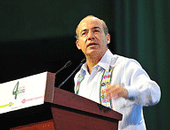Cancún climate talks led to sound forest deal
Key issues were still up in the air during the last day of the 16th world climate conference (COP 16), the 12th of December; negotiations had been exhausting and often seemingly fruitless.
And then, shortly before closing time, the pieces fell into place: Broad consensus on the way forward was almost miraculously achieved among the 194 country delegates participating in the conference, as laid out in draft text, with Bolivia as the only exception. This text may provide the basis for moving on to a legally binding agreement at the COP 17 to be held next year in Durban, South Africa.
The Rainforest Alliance and NEPCon were represented by a team of experts within forestry, agriculture and climate change. Rainforest Alliance Climate Program Director Jeff Hayward says: “The agreement represents moderate ambitions compared to the ideal situation, but it is still a major milestone for the world’s efforts to halt climate change. On the forest side, there is consensus on a way forward which doesn’t compromise key forest values, but sets out to strengthen and support those values. That is very significant”.
REDD+ recognizes the wider role of forests
The agreement clearly recognizes the role of the world’s forests and sets out the key framework for the so-called REDD+ framework (REDD stands for Reduction of Emissions from Deforestation and Forest Degradation).
Already during the Copenhagen climate talks last year, there was broad consensus that REDD+ is an important opportunity to mitigate climate change, and this view was further confirmed during the COP 16 conference. Most importantly, the agreement calls for including social and environmental safeguards to accompany REDD+ activities and for development of national level forest monitoring and reporting , with sub-national monitoring and reporting being acceptable as an interim measure. The scope of REDD+ remains intact, encompassing not only reduction of emissions from deforestation and forest degradation but also conservation of forest carbon stocks, sustainable management of forests and the enhancement of forest carbon stocks. These points are likely to make an essential difference to the way REDD+ programs or projects will impact forest lands and forest-depending communities in years to come.
Most importantly, the agreement calls for including social and environmental safeguards to accompany REDD+ activities and for development of national level forest monitoring and reporting , with sub-national monitoring and reporting being acceptable as an interim measure. The scope of REDD+ remains intact, encompassing not only reduction of emissions from deforestation and forest degradation but also conservation of forest carbon stocks, sustainable management of forests and the enhancement of forest carbon stocks. These points are likely to make an essential difference to the way REDD+ programs or projects will impact forest lands and forest-depending communities in years to come.
In line with this, the text calls for including social and environmental safeguards to accompany REDD+ activities. The wording points towards REDD+ as a vehicle for strengthening good forest governance structures, transparency and monitoring of forest activities, securing communities’ rights and promoting biodiversity conservation.
Forest people had their say at Forest Day 4
For the 4th consecutive year, CIFOR organized the increasingly popular Climate COP side event called Forest Day. Forest Day has developed into a globally important forum where forest stakeholders from around the globe come together to discuss how to accelerate the integration of forests into climate mitigation and adaptation at both local and global levels.
Forest Day 4 brought together more than 1,500 of the world’s leaders and experts, practitioners and policy makers, advocates and investors, indigenous people and community representatives.
The importance of the Forest Day event was further accentuated through the direct participation of the President of Mexico, Felipe Calderón. In the plenary, Calderón insisted to “push hard for the full incorporation of REDD+ into a long-term international climate change agreement”.
This is precisely what happened at the conclusion of the COP 16.

President Felipe Calderón Hinojosa. Scenes from Forest Day 4, Cancún, Mexico. Photo by Neil Palmer, CIAT
The financing of the REDD+ concept on the ground is not in place yet, but the agreements reached in Cancun should help push the developed countries to make good on the financial commitments made at COP15 last year in Copenhagen, which could total nearly $30 billion by 2012. The parties agreed that both market and non-market approaches to financing REDD+ activities should be considered.
This financing will be targeted towards a suite of “REDD-readiness” activities, such as developing national forest inventories and baselines, building capacity and initiating demonstration projects – - the cornerstones of any successful REDD+ program.
For a more detailed account of the REDD+ concept including references to specific parts of the agreed text, please visit the Rainforest Alliance blog.
NGOs: “more hot air”
Some voices - such as Friends of the Earth International and Indigenous Environmental Network - reject the agreement.
They consider that the text fails for several reasons, including that it could allow global temperatures to increase by more than 4 degrees, a level disastrous for humanity, and that adequate funds are still lacking. According to the critics, the Cancun Agreements are yet more hot air, produced during a closed and non-transparent process.
Jeff Hayward: “The critical NGOs are right in so far that the text could clearly have been more ambitious; this is a compromise text and in terms of the emissions reductions it doesn’t go far enough. At the Rainforest Alliance, we believe that there is a basis for good progress by the UNFCCC, which was strengthened by the COP16 agreement, and without the Cancun Agreements, we would have witnessed its unraveling and the death knell for the UNFCCC. Its work is cut out for the year ahead, but it has a future”.